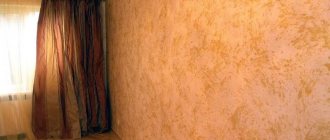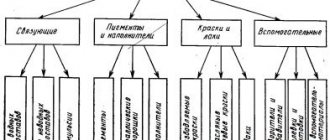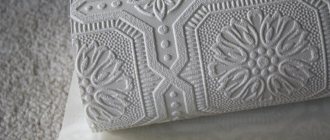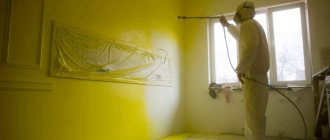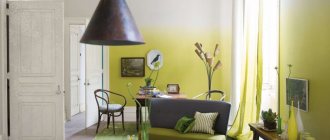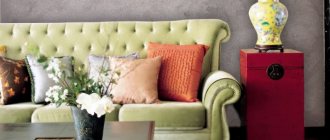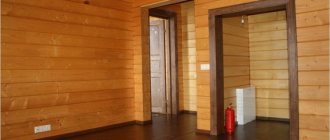How to properly paint or paint walls
In this article we will not talk about the norms of the Russian language, as it might seem, but about more prosaic things...
So, finally you will find out once and for all what is correct: coloring or painting.
The surface to be painted must be carefully prepared. It is not possible to achieve high-quality painting on a poorly leveled, dirty, dusty or greasy wall. Painting walls requires some experience, so you need to thoroughly prepare for the process. If you plan to do the painting yourself, you need to know at least the basics of painting to avoid poorly painted surfaces.
Morphemic analysis of the words “painting” and “coloring”
To consolidate the spelling of the word, let’s analyze it by composition:
by color
- prefix: “po-”;
- root: “-kras-”;
- suffix: “-k-”;
- ending: "-a".
Consider the composition of the noun “coloring”:
o kras k a
- prefix: “o-”;
- root: “-kras-”;
- suffix: “-k-”;
- ending: "-a".
The nouns have a common root “-kras-” and different prefixes. Similar words differ in meaning and usage.
Stage 1 – preparing walls for painting
Walls for painting are prepared in a special way - the entire working surface must be carefully prepared. A highly absorbent surface will lead to excessive paint consumption and uneven drying, which will also affect the quality of the paint. The result of violating these conditions can be seen immediately after applying the paint - this is an uneven layer with veins. Before painting walls, porous substrates must be primed. The walls must be well dried before painting. Do not paint a damp or wet surface. The same rule applies to applying subsequent layers of paint. Paint loses adhesion (sticking) to wet substrates, and this can cause the appearance of “dummies”, even after some time has passed after the paint has dried. Thus, preparing walls for painting is not at all as difficult as it might seem at first glance. As a result, high-quality wall painting or painting should be prepared according to the above instructions.
In what cases is it written “coloring”
The noun has several meanings:
- the process of action according to the meaning of the verb “color”;
- object of action according to the meaning of the verb “color”;
- color, shade;
- in a figurative sense: a special tone, emotional component, shade.
The word is used if speech describes the natural color of something: skins, animal fur, bird plumage, insects, grass, leaves.
When referring to animals, the cognate noun “color” is used.
Example: color of kittens, color of parrot. But: the color of a kitten's fur, the color of a bird's plumage.
Example sentences
To reinforce the use in speech, let’s look at a few examples:
- Dying the feathers for the Apache Indian costume took a lot of time and required precision.
- The harmless story was supplemented by a small scandal, after which the mysterious disappearance of the main character occurred. As a result, the novel acquired a criminal overtones.
- The color of the kitten's fur may change and become orange.
- The parrot's plumage had an unusual color. But this only attracted buyers.
- The inconspicuous mushroom was not brightly colored, and it turned out to be difficult to find.
Stage 2 – applying paint
The paint must be applied in a thin layer and evenly, rolling it out as much as possible with a roller. As a result of careless or incorrect painting, the surface of the wall will be uneven - traces from the roller or brush (stripes on the wall) remain visible. Wall painting options are selected depending on the interior style.
The process of painting the wall must be continuous, and the roller movements must be made in one direction. So, with the vertical painting method, movements are made from top to bottom with overlapping stripes. Experienced artists use the V-shaped principle. The paint is applied to the wall in a V-shape and quickly rolled left and right. Do not press the roller too hard while painting - marks from the edges of the roller will remain on the wall. It is best to overlap the stripes by at least half the width of the roller, so the transition will not be visible. Excessive thinning of paint will result in poor paint quality. A thinner consistency is only suitable for the first (primer) layer. The cost of painting walls always varies and it is better not to skimp on quality paint.
The cause of brush or roller marks may be the painting process at too high a temperature and dry air. Usually, trying to correct a smooth, dry surface does not give good results - the “correction” spots will be visible from a certain angle.
Painting a wall with high quality is not at all difficult - the main thing is to follow these instructions. It doesn’t matter what you call it – wall painting or painting. The result must be long-term and reliable.
Room painting
1 Types of paints for interior spaces
For painting interior walls, as well as for painting ceilings, emulsion paints diluted with water are most often used. They are easy to apply, spread well over the surface, are resistant to various influences and are easy to clean. Most of them are matte paints. The properties of emulsion paints (resistance to washing off, abrasion and the so-called coating strength) depend on their grade and the quality of the resins and pigment used for their production. These factors affect the price of the product. Among the wide range, you can choose both single-layer paints and paints that should be painted in two or three layers to obtain a smooth, beautiful surface.
The most commonly used types of paints are:
Acrylic paints
– based on acrylic resins: they spread well, do not have an unpleasant odor, are durable, and have good covering properties. There is a large selection of acrylic paints with different parameters of covering properties and resistance to washing off;
Vinyl paints
– easy to use, gives the surface a beautiful matte finish. The surfaces covered with them are susceptible to contamination, but are easy to clean. Unfortunately, they do not allow water vapor to pass through well;
Painted or painted correctly?
In Russian, these two words are synonymous, but the use of one word or another depends on the general context of the sentence.
Painted is a short passive participle, derived from the verb “to paint.” The word has a broader meaning; it is used to indicate that an object is painted a certain color as a result of work done on it, as well as to characterize the natural color of something (the color of an animal’s skin, bird feathers) or the already existing color of an object. It is often used in a figurative sense to give a color characteristic to something (report, speech, etc.). The product is painted blue The walls are painted beige Young leopards are painted somewhat lighter The parrot feathers are painted very brightly The apple is painted in yellow-red tones The speaker’s speech is painted in negative tones The report was emotionally charged
Painted is a short passive participle, derived from the verb “to paint.” The word is used to indicate that the color of an object has been changed as a result of mechanical action (the application of paint). The product is painted white The car is painted blue This window is painted with very expensive paint
“ Carefully painted ” and “ Carefully painted ” are stable expressions that can be equally used in the Russian language.
How to paint the walls in an apartment correctly?
Despite the emergence of new materials and technologies, wall painting remains one of the most common finishing options. Moreover, a large number of consumers consider this process simple and labor-intensive. Therefore, they take on the work themselves, trying to save the family budget.
How to paint correctly
However, there are pitfalls here. And if they are not taken into account, then repairs, instead of savings, can bring complete losses.
What do you need to know when starting painting work?
In what cases is it written “painting”
The noun in question has fewer meanings:
- the result of the action according to the meaning of the verb “paint”;
- the process of action according to the meaning of the verb.
The word is not used in a figurative sense.
Example sentences
Here are a few examples for a better understanding:
- Painting the entire car will be very expensive. More profitable option:
Professionally paint over and varnish scratches.
- Grandfather spent all his savings to paint the damaged fence.
- The eldest of the boys was tasked with painting the gate. He set to work with enthusiasm.
- Lyuba enjoyed gluing wallpaper and taking out the trash, but painting was a real punishment for her.
- Painting of the craft was postponed until next Thursday. There was not enough yellow paint.
Painting stages
Let's start by choosing paint for the walls. The variety of materials is huge, so you can always find a suitable option.
But let's not stop at paint. After all, our goal is the technology of painting walls.
Preparatory stage
The work process begins with the preparatory stage. You should immediately take into account that painting walls is the application of a thin layer of finishing material, so all flaws and defects of the wall surface will be visible. This means that it needs to be leveled as much as possible and made smooth. Don't forget about strength.
So, first of all, it is necessary to remove the old finish from the wall - even if it adheres well to the surface. Ideally, it would be good to get to the concrete base or plaster.
Next, you will have to examine the wall for cracks, chips, gouges and other defects that need to be removed immediately. To do this you will need a putty solution.
After application, it needs to be allowed to dry and then primed with a deep penetration primer. This material, having penetrated the body of the wall, firstly, will strengthen it. And, secondly, it will provide the surface with high adhesion.
Important! Please note that it is prohibited to carry out the next stage until the primer has dried. This will take at least 6 hours, depending on the ambient temperature.
Now you can apply putty as a leveling layer. To do this, buy a coarse-grained solution - such as Fugenfüller.
Preparing the walls
The putty must be applied in an even layer to hide all differences in the wall surface. After completing the work, leave time for drying, which lasts at least a day. Then prime the wall again and dry again.
All that remains is to apply the final finishing layer of putty, which will create a smooth surface. This will be a thin layer of a fine-grained mixture, which is called finishing putty. After it dries, it is necessary to sand the surface with sandpaper or a special synthetic mesh. The result should be a perfectly smooth wall. And at the end of the day - another layer of primer.
That's it now - the preparatory work is completed.
Painting the wall
Let’s immediately make a reservation that painting walls can be done with different paints and varnishes.
Painting with water-based and water-dispersion paints
Most often it is water-based or water-dispersion paint. And since both types use water as the base, their application technology is the same.
Several types of tools can be used to apply paint:
The best option is a roller, but a brush is useful for painting hard-to-reach places and corners of the room.
To properly apply water-based paint to walls, you need to know the technology of the process - especially the number of layers of material and the directions in which they should be applied. Usually the water-based emulsion is “laid” in 2-3 layers. But the direction of application is chosen according to the following scheme:
- If a two-layer coating is used, then the first layer is laid across the wall, and the second along the height.
- If 3 layers are expected, then the first and third are applied lengthwise, and the second across.
At the same time, it is not necessary to wait for each layer to dry, since the process is carried out using “wet” technology. This significantly reduces work time.
Finishing with enamel paints
A completely different technology is used for enamel paints. The material is applied to the wall in the form of zigzag lines and then smeared over the entire surface in different directions. This is best done with a brush. This will ensure the paint is evenly distributed and becomes a single layer. After this, you can apply another layer along the height of the wall with a roller.
Wall painting
This process may seem too simple to some. In general, this is how it is. But even here you will have to tinker a little. After all, it is not always possible to distribute the material evenly. Therefore, experts advise not to use a roller over the same place several times. One layer is usually always enough.
We use a spray gun
Of course, a spray gun is the optimal tool for applying paint evenly and economically to the wall. But even with it you need to work correctly.
Using a spray gun
So take into account expert advice:
- The paint should reach the ambient temperature. In addition, it needs to be stirred well so that there are no lumps left, and strain through a couple of layers of gauze.
- A very important indicator is the pressure under which the paint flies out of the spray gun nozzle. So take the test. Apply paint to a small area of the wall and see if streaks form. If they are, then either reduce the pressure, or your paint is too liquid. When painting walls in an apartment, it is better to use a low-pressure spray gun, which can be powered by a regular vacuum cleaner. In this case, the paint can must be filled with material to 3/4 of its volume.
- You need to keep the spray gun at a distance of 0.7-1.0 meters from the wall, without changing it during the entire process.
- The technology for applying layers of material is exactly the same as in the case of a paint roller.
- When working with a spray gun, you must use protective equipment in the form of glasses, a respirator and gloves.
- This method does not require a brush to paint hard-to-reach areas.
How to spell it correctly?
Both nouns are formed in a suffixal manner from the verbs: “to paint” and “to paint.”
They, in turn, are derived from the verb “to paint” by adding prefixes.
The prefix “o-” means the action is directed in different directions, spreading over the entire surface of the object or around it. The prefix “by-” changes the meaning of the verb to bring the action to the desired limit.
The noun from the verb “color” is correctly written: “coloring”.
The word derived from “paint” is “painting”.
How to paint correctly.
But very often people who are going to paint on their own are faced with the question: how to paint correctly? Let's try to understand this issue.
After the choice of paint has been made, all the necessary tools and the paint itself have been purchased, all that remains is to start painting. By the way, before painting, do not forget to carefully prepare the surface: putty, level and prime, if necessary.
To calculate paint consumption, you can use a paint consumption calculator.
Applying paint.
You can apply paint
Often, it is rarely possible to obtain a high-quality decorative coating after painting the surface in one layer, so the paint must be applied in several layers.
The top layer is a primer . It is necessary to apply a primer or primer paint to the base; in rare cases, you can also use a heavily diluted base paint.
The next layer is the so-called underlying layer . This layer helps to even out the color and provides a level surface for the final finishing coat.
Adhesive-based paints are usually applied in 2 layers, water-based paints are applied in 3, and some glossy coatings require six or more layers.
Painting with a brush. If you apply paint with a brush, keep in mind that there are simple rules for painting with this tool:
- The brush is held with a slight inclination to the surface.
- Dip the brush into the paint approximately 1/3 ¼/length of the bristles.
- Excess paint must be squeezed out on the edge of the can.
- You need to start work from hard-to-reach places and corners, smoothly moving to flat areas.
Roller painting . Complete with paint rollers you can often find a special tray on which the paint is “rolled out”. The special cellular texture of the flat part of the pallet allows you to remove excess paint from the roller, as well as evenly distribute it over the “coat” of the roller.
Spray painting. If you choose a spray gun for work, carefully read the instructions for it, as well as the recommendations on the paint can. The paint will need to be diluted to a working thickness (it should flow freely through the outlet of the non-working spray gun). When painting, the spray gun must be kept at a distance of 20-60 centimeters from the wall, and moved 5-30 centimeters per second away from you. Be sure to monitor the paint level in the tank: if air gets into the nozzle, an uncontrolled release of paint may occur.
Painting with aerosol paints. If you bought paint in an aerosol can, then when working with it you also need to maintain a distance from the surface. If the distance is too small, the paint will bubble, if too large, the coating will not adhere well. In addition, paint should be sprayed only while the container is moving, otherwise an excess amount of paint will get into one place and drips will form. When applying paint from a can or using a spray gun, make sure that the paint does not get on or stain surrounding objects.
Finding the answer
Total found: 17
| Question No. 297012 |
Hello! Please tell me which formulation is correct: “environmentally friendly material” or “environmentally friendly material” (about natural wool yarn); “eco-friendly yarn dyeing” or . Thank you!
Russian help desk response
That's right: environmentally friendly material, environmentally friendly painting method.
| Question No. 293814 |
Hello! Please tell me how to find the answer to my question? I wrote to you for the first time, but now I can’t find the answer on my own. The question was the following: what is the stylistic connotation of the words lie and lie, which of these words is a neutral synonym for the word deceive. Which dictionary contains such information. Thank you. Best regards, Olga.
Russian help desk response
Dictionaries mark lie as a colloquial word. Lying and deceiving are stylistically neutral options. You can refer to any standard explanatory dictionary of the Russian literary language published in the last decade.
| Question No. 293733 |
Monster and monster. Good afternoon Tell me, please, are these complete synonyms? Are there any differences? Are both derived from "miracle"? Which one is older? Thank you!
Russian help desk response
These words, of course, go back to the same root as miracle. They are not complete synonyms. The word monster has three meanings: 1) a terrible fairy-tale creature (a monster with three heads); 2) about who (what) inspires fear, horror (prehistoric monsters); 3) about a person of low, repulsive moral qualities. The word monster is synonymous with the word monster in the first two meanings (cf. monster with three heads, prehistoric monsters), but its third meaning is about an extremely ugly, ridiculous-looking, strange person (where did you meet this monster?)
Thus, these words differ in one of the figurative meanings, in addition, their stylistic coloring is also different: the word monster is colloquial.
| Question No. 288758 |
Hello! Tell me, please, does the word “bunk” have a stylistic connotation?
Russian help desk response
The word bunk is stylistically neutral if used in its literal meaning.
| Question No. 288379 |
Your opinion on the compatibility of the words “thoughtful initiative” is important. Is such a combination of words possible? If so, does it have a negative or other stylistic connotation? Or there was a mistake in this phrase, i.e. Is lexical compatibility impaired? Thank you for your reply.
Russian help desk response
The combination is possible, there is no negative connotation.
| Question No. 285746 |
I saw the expression “dying clothes” in the advertising text. Is this usage legal? It would be more appropriate to use the words “coloring” or “coloring” in this context?
Russian help desk response
This usage is incorrect. Correct: p dyeing, dyeing, dyeing clothes.
| Question No. 283962 |
Hello! Tell me which word is more correct to use: painting, painting or painting - in the following sentences: One of the important areas of landscaping is painting metal structures and equipment. Alkyd paints were used for exterior painting of objects.
Russian help desk response
Related article: How to glue a bathroom mirror to a wall
| Question No. 278365 |
What is the correct way to write: “color comparison standard” or “paint comparison standard”?
Russian help desk response
There are both words - coloring and n coloring.
| Question No. 273989 |
Which is more correct in an official document: sunset or sunset? Or is there another synonym?
Russian help desk response
That's right: sunset and sundown. The word sunset is also used in figurative meanings:
- Sunset time. Return home at sunset. After sunset it became noticeably colder. Work from sunrise to sunset.
- Coloring, illumination of the sky above the horizon at sunset. Admire the sunset. Draw, shoot h.
- End, exodus, decline. Z. youth. Z. ancient civilization. Z. Age of Enlightenment. Golden z. Roman Empire. Life is coming to an end. ◊ On the order of those days (life). In old age. At the end of his days he decided to get married.
| Question No. 266004 |
Please help me understand what is the semantic difference in the phrases “break from work” and “break from work”? I would be very grateful for a detailed answer with more complete rules for using this word.
Example: "Painting a single area can be a welcome break from the persistent painting of walls."
Thank you very much in advance.
Russian help desk response
That's right: a break from persistent painting of walls. True, we must say that in this case it is better to replace the word stubborn or reformulate the entire sentence.
| Question No. 263548 |
Hello. Tell me, please, is it possible to put an equal sign between the words “ambition” and “desire”? Are they equivalent? And what is their stylistic coloring? Thank you.
Russian help desk response
These words are not equivalent. You can find their interpretations in electronic dictionaries on our portal.
| Question No. 249905 |
which is correct: indigo dyeing or indigo dyeing
Russian help desk response
Maybe: n indigo dyeing?
| Question No. 247296 |
Please, urgently too! Painting (gun metal). About the car. Do I need to put it in quotes? THANK YOU!
Russian help desk response
| Question No. 247136 |
The word "simp". Paronyms, homonyms, phraseological and set phrases, grammatical characteristics (morphological features, forms of word formation, syntactic speech, stylistic coloring) of the word “simp”. Help me please.
Russian help desk response
| Question No. 240012 |
Hello! Please answer urgently: color or color in this sentence: “In the so-called “bird museum”, guests saw feathered pets of the most fantastic colors and sizes.” Sincerely. Thank you.
Russian help desk response
We offer: In the so-called bird museum (without quotes), guests saw feathered pets of the most fantastic sizes and colors.
How to paint walls correctly.
Painting the walls is done with a small brush (flat brushes) from the upper corners. The paint must be applied horizontally, gradually moving from top to bottom. If the surface is large, it is better to use a large brush or a suitable roller. If you are painting a wall segmentally or you need to get an even border of color, you can safely use masking tape.
Attention: each layer of paint must be applied in a direction perpendicular to the previous one. Do not apply excessive amounts of paint to the surface. After application, it is recommended to rub the paint well to avoid drips. The finishing coat should be applied using wide strokes from top to bottom. If you are using quick-drying paint, apply it in short strokes all the time in the same direction.
How to properly paint doors, windows, radiators.
The door and door frame should be painted at different times, especially if it is not possible to remove the door from its hinges. The paneled door must be painted in the following order:
- Paint from the vertical edge of the panel,
- Then proceed to painting the panel itself,
- Then process the central vertical part,
- After that - the outer verticals and finally - the outer edges.
When painting a door, you must remember that the movement of the brush should be directed along the fibers.
Before painting wooden windows , you should remove the fittings from them, this is done so that the work looks more neat, besides, you do not need to cover all parts of the window with tape and make sure that the paint does not get on the handles and latches (especially if they are decorative). Take care of protecting the glass; you can protect it with tape.
After the above steps, proceed to painting the strips with which the glass is attached.
For this work, it is better to use a small thin brush (for example, a panel brush) or a brush with an oblique cut. You should start painting from the internal surfaces, after which you need to give them time to dry and only then move on to the external ones. The ends of the frames, window frame, slopes and window sill are painted last.
If paint suddenly gets on glass or another surface, it should be removed using a suitable solvent.
Painting and staining are the difference. Varieties of “transition” coloring
Considering that the vast majority of cars are now painted using a two-layer “base + varnish” system, one should, first of all, distinguish between two transitions:
- according to the base,
- on varnish.
Both transitions can be performed either separately or in combination. Often only one of the transitions is performed on a part. For example, they make a transition “along the base” and cover the entire part with varnish.
Transition painting is used in the following cases.
Coloring with a transition to an adjacent element
This “transition” option is considered the most difficult.
In practice, it is most often used when replacing body parts. The most typical example is replacing the front fender. Obviously, painting the fender end-to-end with the door will result in a difference in shade on the two elements. If we “climb” paint onto the door, we will be able to achieve a smooth transition of color and get a shade that matches the shade of the original. At least that's how it appears to the human eye.
Touch-up within an element
Although this touch-up option is the most common in practice, it is not always possible to perform it efficiently - it all depends on the size of the damage and its location on the body part.
If the damage is minor and located in the least noticeable part of the panel element, closer to its edge, then yes - such damage can be recommended for making a transition within one part. This may include minor damage to the edges and lower areas of doors and fenders, and bumpers.
It is not recommended to touch up significant damage in the center of parts, much less horizontal ones (hoods, roofs). Especially when it comes to complex colors, such as silver metallics.
If you decide to touch up, for example, the hood, then it is permissible to carry out the transition only along the base, but you need to varnish the element completely. We're talking about the face of the car, aren't we?
Decorative paints and their application.
The easiest way to get a decorative coating is to apply paint with a sponge.
For decorative painting, you can use undiluted emulsion paint; for wood and metal, oil paint is the best option. A natural sponge is best suited for this task. Before starting work, soften the sponge in water or white spirit. For high-quality coloring, it is better not to dip the sponge into a jar, but to use a shallow container with a small amount of paint (for example, a roller tray). When painting, the sponge should be rotated so that the pattern is irregular; the paint should be applied with light jerky movements. To paint corners and baseboards, use an almost dry sponge with a minimal amount of paint, because in hard-to-reach places you involuntarily have to press the sponge harder and the design may become smudged.
Other materials can also be used for decorative painting - fabric strips with an interesting texture or with knots tied on it, special textured rollers, brushes, various stamps and stencils. In general, any item with an interesting pattern or unusual texture will help you create a unique decor.
